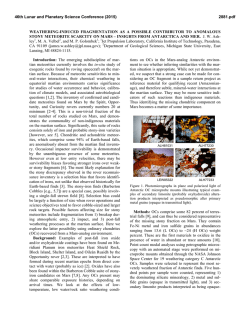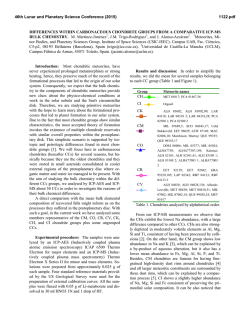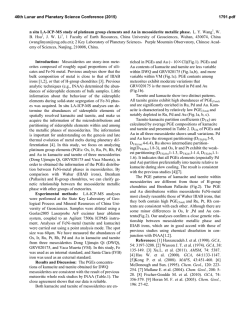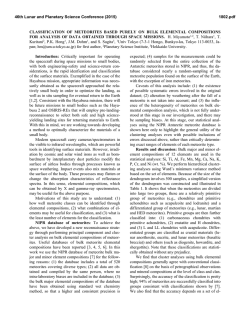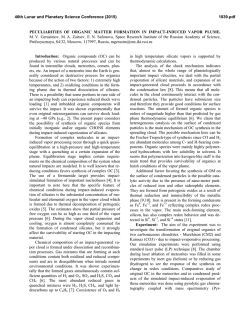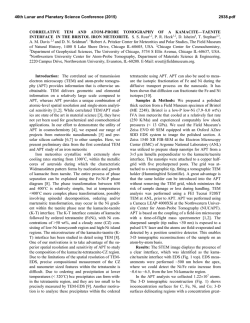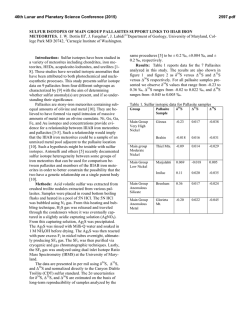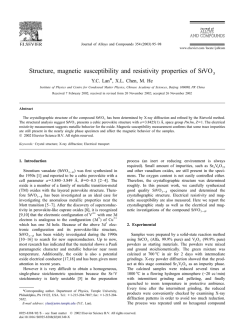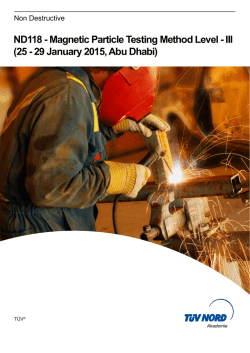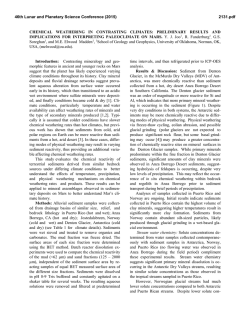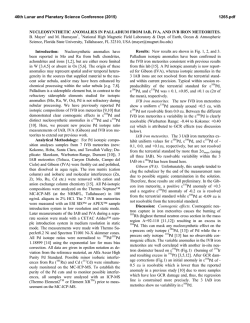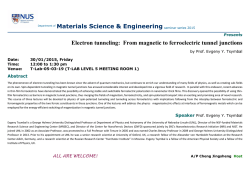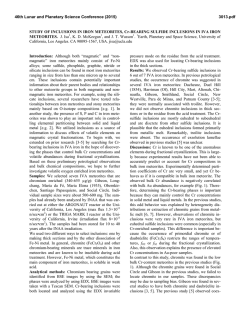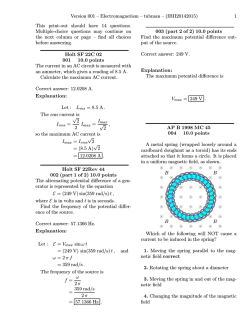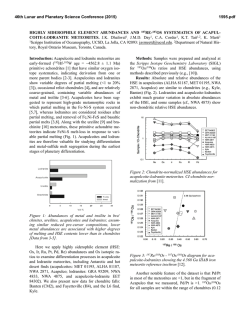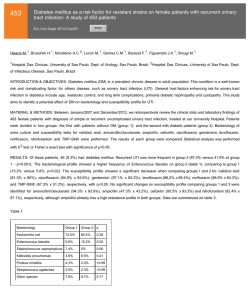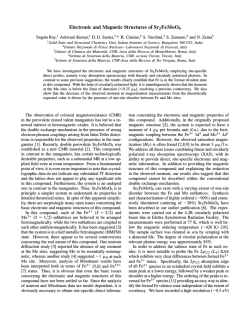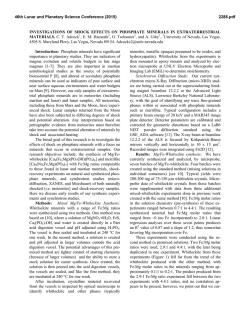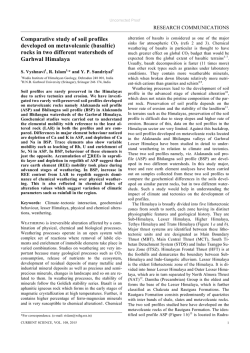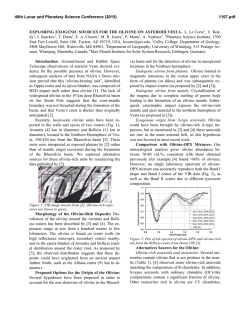
COLD DESERT WEATHERING EFFECTS ON MAGNETIC
46th Lunar and Planetary Science Conference (2015) 2046.pdf COLD DESERT WEATHERING EFFECTS ON MAGNETIC PROPERTIES OF L6 CHONDRITES. E. D. Steer1, J. Gattacceca2, P. Rochette2, S. P. Schwenzer1, I. P. Wright1, M. M. Grady1, 1Department of Physical Sciences, The Open University, Walton Hall, Milton Keynes, United Kingdom, MK7 6AA. 2 CEREGE, UM 34, CNRS, Aix-Marseille Université, Aix-en-Provence, France. ([email protected]) Introduction: Antarctic weathering of ordinary chondrites primarily affects Fe-Ni metals [1, 2] which are the main magnetic minerals of the meteorites [3, 4]. The magnetic properties of meteorites can thus be used as proxies to weathering state. The alteration products resulting from oxidation and weathering of the metals can also have magnetic properties of their own [5]. However, the mode of weathering that operates in different environments varies, as do the products. As such, understanding how the magnetic properties are affected in Antarctica is important to recognize and understand. Samples: Six L6 chondrites collected from Antarctica were used in the study: QUE 94214, QUE 99022, ALH 78130, ALH 85017, ALH 84056 and ALH 84058. The magnetic properties of rim and interior chips of all, between 1-3 g mass, were measured. The meteorites used cover the range of weathering and fracture grades as set out in the Antarctic Newsletter [6]. Thin sections of the rims and interiors of each meteorite were used for petrological studies. All rim sections are clearly identified from the presence of fusion crust. Methods: An extensive petrological study was undertaken at The Open University using reflectance and transmitted light microscopy, Scanning Electron Microscopy (SEM) and Electron Microprobe Analysis (EMPA). A FEI Quanta 3D dual beam SEM fitted with an Oxford Instruments 80 mm X-MAX energy dispersive X-ray detector was used to obtain images and element maps. Consequent images of the thin sections of each meteorite, rim and interior, were analysed in tandem with element maps using an image processing software package (imageJ) to quantify the ratio of metals and sulphides to resultant alteration product. Mineral analysis was obtained from a Cameca SX100 EMP using the following conditions: spot size of 10 µm, accelerated voltage of 20 kV and a beam current of 20 nA. All magnetic studies were undertaken at CEREGE. Susceptibility was measured using a Agico MFK susceptometer (frequency 976 Hz, applied field 200 A/m). Hysteresis measurements were performed using a Princeton Micromag Vibrating Samples Magnetometer. Petrology: The classifications of the six L6 chondrites are confirmed from pyroxene and olivine compositions and microscopic studies. The meteorites cover a wide range of weathering grades (see *table 1) and shock stages. The shock stages were ascertained using optical microscopy [7]. The main product of the Ant- arctic weathering is Fe-oxyhydroxides, which follow from the breakdown of kamacite, taenite, tetrataenite and troilite. Five out of the six meteorites demonstrate a weathering pattern consistent with the initial breakdown of kamacite, followed by taenite/tetrataenite before the troilite is affected. As the first minerals to weather in Antarctic weathering are the main magnetic minerals of L chondrites [3], the magnetic properties should then be related to the amount of metal transformed to Fe-oxyhydroxides. The proportion of metal transformed to Fe-oxyhydroxide can be a useful proxy to a quantifiable weathering index which should tie in with magnetic changes. The Fe-oxyhyroxides include goethite which is a ferromagnetic mineral. Most of the meteorites demonstrate a similar amount of % oxide in the interior samples compared to the rim. Notable exceptions are QUE 99022 and ALH 84056, which demonstrate significantly more weathered rims than interiors and ALH 78130 which has a significantly more weathered interior compared to the rim. The interior sample of ALH 85017 is also notable for an above average metal content. Table 1 – Summary of the percentage of different metals transformed to alteration products in each sample. ALH 78130 has a more altered interior than rim. This is likely due to the positioning of an open fracture next to where the interior sections were taken. Magnetic properties: Mrs (saturation magnetization) and Bcr (coercivity of remanence) both separate out the more shocked meteorites with lower values for those above shock stage S4 (Fig. 1). In those meteorites which are not affected by levels of shock S5, a general positive trend between Bcr and Mrs is observed, both parameters tracing high coercivity minerals like tetrataenite (primary) or goethite (weathering 46th Lunar and Planetary Science Conference (2015) product). Four of the meteorites (ALH 84056, QUE 94214, ALH 85017, QUE 99022) show a decrease in Ms (saturation magnetization) between the rim and interior of the samples. A general negative correlation is apparent between % altered taenite and kamacite with the magnetic susceptibility (χ) (Fig. 2). An idealized zero alteration point has been added from the average value of a fresh L6 fall by [9] and a theoretical completely weathered point has been added with an assumption of no magnetic secondary minerals having been produced. The line between the two shows the theoretical path of susceptibility with weathering. The main deviation from this trend is ALH 85017 I, which has an unusually large amount of kamacite (as observed in the accompanying thin section). In general, the other meteorites fall along this trend. A weak correlation between Ms and % altered Fe-Ni metal is also observed. Differences between rims and interiors of the meteorites are not consistent between the different meteorite pairs. Discussion and conclusions: Highly shocked meteorites are known to be separated out by Mrs and Bcr because of the disordering of the magnetically hard phase tetrataenite to the magnetically soft phase, taenite [3, 4]. Those samples in this study at shock stage S5 have distinctly lower values, caused by tetrataenite disordering into taenite. Tetrataenite, as a magnetically harder mineral [3, 8], demonstrates a higher coercivity and consequently has significantly different magnetic properties. Susceptibility and Ms directly relate to the % altered Fe-Ni metal as it estimates the bulk quantity of metal (the main magnetic minerals) in the sample and so is in line with the findings of [9]. The meteorites show deviations from the idealised path of susceptibility with weathering. Two possible reasons for these deviations can be inferred: The contribution from the weathering products adds to the magnetic susceptibility, reducing the magnitude of the susceptibility lost from kamacite, taenite/tetrataenite altering or the sample has a unusual abundance/deficit of magnetic minerals as is the case with ALH 85017 I. Fe-oxhydroxides and akaganeite have been identified in the meteorites studied, which can contribute to magnetic susceptibility. This might be contributing to some of the deviations from the idealised pattern. Differences in magnetic properties between rim and interior of samples show no consistent patterns, most likely due to the inconsistent amounts of weathering between the rims and interiors of the meteorites. Instead, discernable patterns in susceptibility come from comparisons with the percentage of altered metal in the samples rather than distance from the fusion crust. This 2046.pdf means that the interior sample of a meteorite is not a guarantee of a fresh, unaffected sample as the interiors of the meteorites do not necessarily demonstrate less altered magnetic minerals. References: [1] Gooding, J. (1982) LPSC XII, 1105-1122. [2] Wlotzka, F. (1993) Meteoritics, 28. 460. [3] Wasilewski, P. (1988) Physics of the Earth and Planetary Interiors, 52. 150-158. [4] Gattacceca, J. et al (2014) MAPS, 49. 652-676. [5] Uehara, M. et al (2012) Physics of the Earth and Planetary Interiors, 200. 113-123. [6] The Meteoritical Bulletin, Accessed 20/11/14. [7] Stöffler, D. et al (1991) Geochimica et Cosmochimica Acta, 55. 3845-3867. [8] Wasilewski, P (1987) [9] Rochette, P. et al (2003) MAPS, 38. 251268. Fig. 1 – R and I refer to rim and interior samples. Shock grades have been annotated on the graph demonstrating that the meteorites with shock grades of 5 all cluster with low Mrs and Bcr values. The lower shock grades show no constant change between the respective rims and interiors. Fig. 2 – Specific susceptibility and % kamacite, taenite and tetrataenite weathered. Red points are the theoretical endpoints of a sample with all magnetic minerals weathered out and replaced with nonmagnetic alteration minerals with the value for a fresh L6 fall taken from [9] to represent an un-altered sample (error bar shows standard deviation). A negative correlation can be seen between % metal weathered and χ as increasing amounts of metal and sulphide is transformed to Fe-oxyhydroxides. ALH 85017 interior has an anomalously high χ due to two large (1.5-2 mm) kamacite and taenite/tetrataenite grains.
© Copyright 2025
